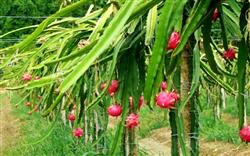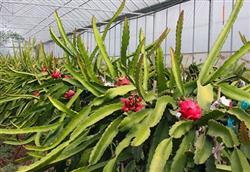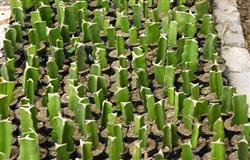Cultivation techniques and field management of dragon fruit

First, the dragon fruit in the garden is more heat-resistant, water-resistant, like warm, humid, sandy soil rich in organic matter. Before nursery stock cultivation, according to the specification of 1.5 meters × 2 meters per mu, 10 × 10 × 250 cm cement square columns were erected, and the cement columns were put into the soil of 50 cm to support the climbing of dragon fruit branches. The cement column was drilled straight holes on both sides of the cement column at 5 cm away from the top, leading two vertical wire crosses for dragon fruit branches to climb. In order to prevent the branches from being overloaded or broken by the wind, a fixed waste tire should be put on the cross to support the branches. The planting holes of 10 cm deep and 20 cm long and 20 cm wide were dug on each side of the cement column, in which rotten organic fertilizer and soil were mixed evenly, 1 plant was planted in each hole, and 4 plants were planted beside each cement column. Second, planting dragon fruit can be planted all the year round, and 4 plants are planted around each column, so that the dragon fruit plant can grow upward along the column. According to the calculation of planting 4 seedlings per column, 450 seedlings can be planted with 667 square meters, which can greatly improve the land utilization rate, increase the fruit yield in childhood and recover the investment cost early. Planting should not be deeply planted (3 cm deep is appropriate). The soil should be kept moist at the initial stage. Third, water and fertilizer management Huolong fruit is more drought-tolerant, watering every 3 days at the initial stage of planting, and then keeping the soil moist. The root distribution of dragon fruit is shallow, and fertilization should be applied for a few times to prevent root burning and rotting. After the seedling germinates, thin human feces and urine can be applied in the planting hole about 10 cm away from the seedling, about 1 kg per plant, and then 0.3% urea and 0.1% potassium chloride will be added to each germination until the dragon fruit blossoms. In the first year, there were 8 times of fertilization, mainly nitrogen fertilizer, combined with potassium, calcium, magnesium phosphate fertilizer and so on. Cover with once mature organic fertilizer or mushroom residue in winter, about 10 kg per plant to enhance the heat preservation and cold resistance of the plant. After flowering and fruiting, fertilizer was applied three times a year, that is, pre-flowering fertilizer in April, strong fruit fertilizer in August and overwintering fertilizer in December, mainly mature organic fertilizer and ternary compound fertilizer. 4. Field cultivation and management the dragon fruit begins to blossom and bear fruit about 12 miles 14 months after planting. It can blossom 15 times a year. The fruit is produced from April to November. The fruit can be harvested 40 days after Xie Hua. The weight of a single fruit is generally 500 Mel and 1000 grams. In the second year after planting, there were more than 20 fruits per column, and the third year entered the full fruit period. if the management level was high, the yield of 667m2 could reach more than 2500 kg, and the early fruit yield was good. Due to the long harvest time of fruit, organic fertilizer should be re-applied every year, and nitrogen, phosphorus and potassium compound fertilizer should be applied evenly for a long time. Potassium and magnesium fertilizers should be added during flowering and fruiting period to promote sugar accumulation and improve fruit quality. Keep the soil moist during the fruiting period, and the tree plate is covered with grass or mushroom residue. When the weather is dry, 3mer will be irrigated once a day. The fixed pruning branch should maintain single branch growth before climbing to the top of the cement column, and after growing to the top of the column (1.3-1.4 meters), it should be coring, promote branching, and let the branches droop naturally, accumulate nutrients, and blossom and bear fruit early. The natural germination power of dragon fruit with good growth is higher, generally 5 new branches can be produced from each branch, in order to increase or decrease the strong fruit branches, during the vegetative growth period every year, each branch can leave 3 branches with strong growth according to the growth situation; during the reproductive growth period, in order to ensure the nutritional requirements of fruit development, all the newly germinated branches should be removed. When interplanting and artificial pollination to grow red meat type dragon fruit, it is necessary to plant about 10% of white meat type dragon fruit. Mutual pollination among varieties can significantly improve the seed setting rate. Artificial pollination should be carried out in cloudy and rainy weather. Before the flowers bloom in the evening or before the flowers are closed in the morning, the pollen can be directly applied to the female flower stigma with a writing brush to increase the fruit setting rate. Huolongguo has a long flowering period and strong flowering ability. It will blossom from May to October, with an average of 2.7 buds per flowering season. After pollination and fertilization is normal, the withered flowers can be cut off by ring carving (retain the sepals below the stigma and ovary). Fruit thinning began when the transverse diameter of the young check reached about 2 cm. Each branch left a young fruit with full development, bright green color, no damage and deformity, and a certain growth space, and the rest were thinned to concentrate nutrients and promote fruit growth. Fruit bagging should be bagged with waste newspapers or Kraft paper bags before the pericarp changes color, so as to keep the pericarp evenly colored and prevent birds, wasps and other bites, wind scraping and sun exposure, so as to improve the commodity value. The growth period of timely harvested fruit varies with production season, buried location and variety. Generally, it can be harvested about 45 days after flowering. Harvesting too late will not only cause fruit cracking, but also cause the local color of the pericarp to blacken, affecting the commodity value. Fruits that need to be stored for a long time or transported over a long distance should be harvested before softening and darkening.
- Prev

Cultivation techniques of dragon fruit in solar greenhouse
Dragon Fruit, also known as Divine Dragon Fruit, is a perennial tropical plant of the genus Cactaceae, native to South America. In order to realize the south-north planting, the fruit was introduced in Langfang City, Hebei Province in 2002. Through experiments, the fruit was successfully produced after overcoming the influence of adverse climatic conditions such as high temperature and drought in the early stage and cloudy and rainy in the later stage.
- Next

Main points of propagation of dragon fruit
The main results are as follows: 1. The cuttings are most suitable in spring and summer. The cuttings should select full stem nodes, which are about 15 cm long. After the wound is air-dried, they can be inserted into the sand bed. About 15 Mel can take root in 30 days, and the roots can grow to 3 Mel and 4 cm transplantable seedbed. 2. The grafted seedlings should be free of diseases and insect pests, strong growth and full stem and flesh.
Related
- Moge, come on! The staff of the peasant association in the producing area of cantaloupe were frightened when the crowd gathered.
- Causes and Solutions of low Fruit setting rate of Apple
- Symptoms and control measures of passion fruit virus disease
- Fruit growing lesson: how do apple orchards keep high yields?
- Can you build orchards in the mountains? What are the pros and cons?
- How to manage the coloring period of Crisson grape?
- This paper introduces the processing technology of two kinds of fig products.
- How much is a month for retired teachers in rural areas by 2020?
- How can strawberry planting increase sugar content? We should pay attention to management in many aspects.
- What are the cultivation techniques on how to improve the yield of golden fruit?

